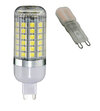The one I got had 69 LED chips, think number G9-69SMD-5730 likely 10 watt and 850 lumen each, but depends on which web site you find them. Toolstation largest is 3.2 watt,
Screwfix site similar, odd but
screwfix still selling quartz halogen, 46 watt 702 lumen was their largest, still less than the 10 watt lamp I have shown at 850 lumen.
I can understand at that output why one wants a dimmer switch, and at 50 watt likely most will work, even if officially 60 - 400 watt. Seems odd as far back as I can remember standard BA22d bulbs were bought in packs with 40, 60, and 100 watt, so 40 watt was always possible load, so why anyone would market a domestic switch with minimum over 40 don't know, the standard down light was common as 35 and 50 watt, did even early on get 10 watt versions, I remember them causing problems where the bulb was replaced with a 50 watt burning out the voltage dropper.
I think the rush to use LED bulbs has resulted in a lot of problems, with strobe effect, flicker, staying on dim, possibly stopping type AC RCD's from working, and forcing the use of programmable thermostats to allow rooms to be warmer in the evening, and linked to that the higher use of energy overall when the contribution to heating the home with infrared is taken into account.
It was a typical governmental knee jerk reaction, without considering the consequences, a very blinkered approach, don't get me wrong, I think LED lighting is good, but not for energy saving, but for the reduction in maintenance. But we have instantiated rules like products should be supported for 7 years, so to stop selling tungsten bulbs before 2030 is going against the governments own rules.
Soon they will find some thing wrong with LED and return to oil lights hanging on the wall.



